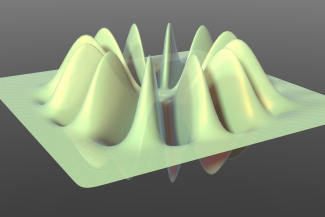Incredibly sensitive measurements can be made using particles that are correlated in a special way (called entanglement.) Entanglement is one of the spooky properties of quantum mechanics – two particles interact and retain a connection, even if separated by huge distances. If you do something to one of the particles, its linked partners will also respond.
However, entangled quantum states are notoriously fragile. This fragility is an inherent part of their nature. Even so, a recent publication suggested an experimental setup using atoms trapped in a rotating ring of laser light as a way to create entangled particles that are protected from destruction. Unfortunately, new work by Fellow Ana M. Rey (with Andreas Nunnenkamp of Yale University and Keith Burnett of the University of Sheffield) shows that this work doesn’t hold water when you consider what is actually possible in the lab. Rey and her colleagues have actually helped experimentalists avoid fruitless attempts to use the rotating-ring assembly to produce stable entangled particles.
The fragility of entangled particles makes it a challenge to use them in quantum measurement. Physicists often use beams of “normal” non-entangled particles — of light or matter — to precisely measure various physical properties. However, such measurements can be made even more precise by using particles with the quantum properties of entanglement and superposition. Superposition is a state in which a particle holds two different properties — such as red and blue, or spin-up or spin-down — at the same time. Once particles in a superposition state are entangled with one another, it’s possible to obtain much more information by measuring a whole group of correlated particles than by measuring any single particle.
Unfortunately, measuring entangled superposition states can destroy them. Because the particles are linked together, if you measure one particle (to determine if it is red or blue, for example), the other one “knows.” This knowing causes the particles to lose their entanglement and superposition; in other words, they become normal independent particles with a single property (i.e., one is red, the other blue).
One way for an entangled state to be more robust is if there is a big step in energy between the entangled state and the rest of the world. With such a large energy gap, little nudges to the entangled state are less likely to destroy it. But there’s a problem here, too: The more particles in the entangled state, the smaller the protective energy gap. Thus, the challenge is to find a way to make entangled states with enough particles to be useful, but with an energy gap sufficiently wide to protect it from destruction.
One common way to make entangled states is to place atoms in an optical trap shaped like a donut, or toroid (Figure 1). Atoms are trapped at certain locations within that toroid by a criss-crossing pattern of laser beams that create comfortable resting places for the atoms, as shown in the figure. If the optical trap is then rotated, the atoms naturally rotate along. However, because of the strange nature of quantum mechanics, the atoms can only rotate with certain restricted rotational speeds. If the toroid is rotated at a particular speed that is forbidden to the atoms, then the atoms will try to rotate both with a speed that is lower than that speed and a speed that is higher than that speed. Now the atoms are in a superposition of fast and slow.
As these fast/slow atoms bump into one another, they start to act in sync, achieving the coveted — but delicate — state of entanglement called a “cat state.” In a cat state, all the particles are in two diametrically opposed states, such as fast and slow, at the same time. However, cat states — like other entangled states — are extremely fragile; the more atoms in the ring, the smaller the protective energy gap. For this reason, only a few atoms can be put into a cat state at once.
Recently, a researcher in New Zealand claimed to have found a way around this problem by placing a tiny bump-like barrier in the donut somewhere. This barrier is a repulsive point where the atoms can’t go. If the bump so thin that is has zero width, the protective energy gap of the cat states supposedly increases as the number of particles increases. However, Rey and her colleagues realized that this mathematical result is physically unrealistic.
It’s simply not possible to create a barrier that is truly infinitesimally thin. When Rey and her colleagues redid the New Zealand team’s calculations using a barrier of measureable (but very thin) width, they found the same thing that they had always found: Once the particles are in a cat state, the protective energy gap dwindles quickly as more particles are added to the system. In fact, experimentalists may be hard-pressed to create entangled cat states with more than about six particles. This limitation poses a challenge for the use of cat states in precision quantum measurement. — Stephanie Chasteen




